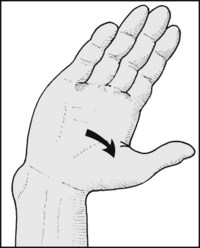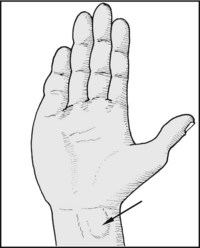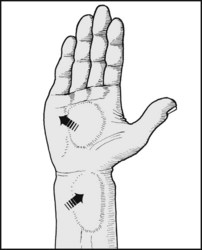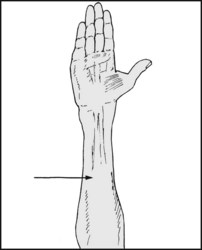CHAPTER 6 The wrist
Study of the wrist cannot be separated from that of the hand, and in many cases careful examination of both may be required.
Complications Occurring After Colles’ Fracture
Considering the incidence of Colles’ fracture, the commonest of all fractures, it is surprising that complications from this injury are not seen more frequently; nevertheless, they do occur and are of importance. Excluding initial weakness of the wrist, the commonest complaints are of residual deformity, restriction of movements and pain.
The common deformities are radial deviation of the hand and prominence of the ulna. Owing to resorption of bone at the fracture site during healing, there is shortening of the radius with radial deviation of the hand. This may be aggravated by a poor reduction. At the back of the wrist, the head of the ulna becomes prominent. (Gross subluxations of the ulna of this pattern are sometimes referred to as Madelung’s deformity; this term was used initially to describe a condition occurring in adolescents where, following some disturbance of growth in the distal radial epiphysis, often idiopathic in origin, the ulna becomes relatively prominent.)
In all Colles’ fractures there is disturbance of the inferior radioulnar joint. In some cases this is responsible for persisting pain and tenderness just lateral to the ulnar styloid.
Again, disruption of the inferior radioulnar joint is partly responsible for loss of movements in the wrist. This certainly accounts for the loss of supination that causes patients the greatest concern. Although restriction of dorsiflexion occurs after most Colles’ fractures, this seldom gives rise to any functional problems.
Two other important complications are seen after Colles’ fracture: (a) delayed rupture of extensor pollicis longus tendon may occur some months after injury and is due to ischaemia or attrition of the tendon, and (b) Sudeck’s atrophy (complex regional pain syndrome), which is usually diagnosed some weeks after cast fixation has been discontinued, and which is characterised by marked swelling of the wrist, hand and fingers, gross stiffness of the fingers, and decalcification of the carpal bones which is obvious on radiographs of the region.
Regarding treatment of these complications, the patient is generally advised to accept minor degrees of residual deformity and stiffness. When there is gross prominence of the ulna causing symptoms, excision of the distal end of the bone may be advised. Ruptures of extensor pollicis longus are treated by tendon transfer (extensor indicis proprius is generally employed). Sudeck’s atrophy generally requires intensive physiotherapy, and often other measures if much permanent stiffness is to be avoided.
Ganglions
Ganglions are extremely common about the wrist and hand. In many cases they may have a tenuous communication with a carpal joint or tendon sheath. Some are spherical in shape, firm, and have no obvious connection to other structures. Tiny ganglions of this type are common in the fingers. Fluctuations in the size of ganglions and their rupture from trauma is well known, and diagnosis is not usually difficult unless the swelling is small. This applies in particular to small ganglions on the back of the wrist, arising from the radiocarpal joint; local swelling and tenderness may only be obvious when the wrist is palmarflexed. This type of ganglion is often the cause of persisting wrist pain in young women: their symptoms are often labelled as functional when this difficulty in examination has not been appreciated. Excision of most ganglions is advised, and this is essential if the ganglion is producing nerve complications (e.g. if a ganglion in the ulnar tunnel in the hand is producing ulnar motor and sensory loss).
De Quervain’s Disease
Tenosynovitis involving abductor pollicis longus and extensor pollicis brevis is known as de Quervain’s disease. It occurs in the middle-aged. The walls of the fibrous tendon sheaths on the lateral aspect of the radius are greatly thickened, and there is often marked underlying swelling. The patient complains of pain on certain movements of the wrist, and weakness of grip. Treatment is by splitting the lateral wall of the sheath.
Extensor Tenosynovitis
Acute frictional tenosynovitis occurs most frequently in the 20–40-year age group, generally following a period of excess activity. Any or all of the extensor tendons may be involved. The condition has a benign course and usually settles if the wrist is immobilised in a cast for 3 weeks.
Kienbock’s Disease
In this condition the lunate undergoes a form of avascular necrosis. The cause is unknown, but there is commonly a history of trauma. Abnormalities in the shape of the lunate and local osseous alignments have been described. The condition is seen most often in males in the 20–40-year age group, and gives rise to pain on the dorsum of the wrist and diminutions of grip strength. It may be complicated by an accompanying carpal tunnel syndrome. Although the diagnosis is usually established by plain radiographs, in the early stages an MRI scan may be helpful, and a CT scan may be used to detect early fracture or fragmentation, Temporary immobilisation of the wrist in a cast or other support may help relieve symptoms although not affecting the progress of the condition. A number of surgical procedures have been prescribed, none of which has any clear superiority over any of the others, or over conservative management.
Osteoarthritis of the Wrist
Osteoarthritis of the wrist is surprisingly uncommon considering the frequency with which the joint is involved in fractures. It is seen most often after avascular necrosis of the scaphoid following fracture of that bone, non-union of a scaphoid fracture, comminuted fractures involving the articular surface of the radius, and Kienbock’s disease (spontaneous avascular necrosis of the lunate, see above).
Where symptoms are severe, fusion of the wrist (radiocarpal joint) may be undertaken.
Rheumatoid Arthritis
Rheumatoid arthritis of the wrist is common, and extensive synovial thickening of the joint and related tendon sheaths leads to gross swelling, increased local heat, pain and stiffness. Fluctuation can sometimes be transmitted from just above the wrist to the palm, the synovial fluid being displaced from one level to the other underneath the flexor retinaculum (compound palmar ganglion). With progressive joint involvement the carpus tilts into ulnar deviation and subluxes in a palmar direction. The head of the ulna displaces dorsally, disrupting the inferior radioulnar joint and causing painful and reduced pronation and supination. Rarely tuberculosis of the wrist may produce a similar clinical picture, but the multifocal nature of rheumatoid arthritis usually makes differentiation easy.
As far as treatment is concerned, local measures can include the use of night splints; later, synovectomy of the wrist and of the inferior radioulnar joints may be effective in slowing the progress of the condition. Where pronation and supination are particularly affected, excision of the distal end of the ulna may give worthwhile functional improvement. Where there is gross destruction of the joint and marked local symptoms, fusion may have to be considered.
Carpal Tunnel Syndrome
This condition occurs most commonly in women in the 30–60-year age group. Basically there is compression of the median nerve, which leads to symptoms and signs related to its distribution. In some cases premenstrual fluid retention, early rheumatoid arthritis with synovial tendon sheath thickening, and old Colles’ or carpal fractures may be responsible by restricting the space left for the nerve in the carpal tunnel. The condition is sometimes seen in association with myxoedema, acromegaly and pregnancy; often, however, no obvious cause can be found, and it is very frequently bilateral. The patient complains of paraesthesia in the hand: often all the fingers are claimed to be involved, although theoretically at least the little finger should always be spared. Paraesthesia may also radiate proximally to the elbow. There may be pain in the same areas, and weakness in the hand. The symptoms may become most marked in the early hours of the morning, often waking the patient from sleep and causing her to shake the hand or hang it over the side of the bed. In many cases the history and results of the clinical examination are unequivocal. In others it may be difficult to differentiate the patient’s symptoms from those produced by cervical spondylosis, and indeed both conditions may be present at the same time; a trial period of immobilisation of the wrist in a cast or the use of a cervical collar may be helpful. Nerve conduction-time tests, showing a delay at the wrist, may be used to confirm the diagnosis. These studies are being employed with increasing frequency in the practice of defensive medicine.
Most cases are treated quite simply by division of the flexor retinaculum, which forms the roof of the carpal tunnel, thereby relieving pressure on the nerve; the procedure may be performed arthroscopically through a minimal incision. Conservative measures may be tried, especially in cases occurring in pregnancy, when diuretics may be prescribed with success. Other measures include the use of night splints and injections of hydrocortisone.
Note that on rare occasions the median nerve may be compressed proximal to the carpal tunnel. Above the elbow this may be due to a supracondylar bony spur (obvious on radiographs); just distal to the elbow, by the origin of pronator teres; and in the proximal part of the forearm by the sublimis. Proximal lesions of the median nerve give rise to the anterior interosseous nerve syndrome.
Ulnar Tunnel Syndrome
The ulnar nerve may be compressed as it passes through the ulnar carpal canal between the pisiform and the hook of the hamate. Both the sensory and the motor divisions of the nerve may be affected, but often one only is involved. The symptoms therefore may include small muscle wasting and weakness in the hand, with sensory disturbance on the volar aspect of the little finger. The sensory supply to the dorsum of the hand is given off in the distal forearm, so that sensory disturbance on the dorsum of the hand and little finger excludes a lesion at this level. In all cases every effort should be made to exclude a more proximal cause for the patient’s symptoms (e.g. ulnar neuritis at the elbow, and cervical spondylosis). Nerve conduction studies are often of particular value in this situation. The commonest causes of nerve involvement at the wrist are ganglionic compression, occupational trauma, ulnar artery disease, and old carpal or metacarpal fractures.
On the establishment of a firm diagnosis of a localised lesion in the ulnar tunnel, exploration and decompression of the nerve are carried out.
Ehlers–Danlos Syndrome
This is the name given to a number of closely related connective tissue disorders which are due to a collagen abnormality. The condition is comparatively rare (50 000 cases are said to be affected in the UK), with a strong (autosomal dominant) hereditary tendency. It is found in association with Marfan’s syndrome and osteogenesis imperfecta. The skin has a velvety feel and is fragile and hyperelastic; when grasped it can be raised and stretched by a remarkable amount. Wound healing is poor, leading to abnormal and somewhat keloid scarring, evidence of which may be widespread. Cases vary in severity, but in some healing may be so poor that surgery is contraindicated. The walls of blood vessels are affected, and bruising is a common problem. Ligaments lose their resistance to stretching, so that there is usually a striking increase in the range of movements in the affected joints; this is often well in excess of the normal range (sometimes to a grotesque degree), and there may be instability, leading to sprains and dislocations. There is no effective treatment.
Tuberculosis of the Wrist
Tuberculosis of the wrist is now rare in Britain. Marked swelling of the joint is followed by muscle wasting in the forearm, erosion, destruction and anterior subluxation of the carpus. The diagnosis is confirmed by synovial biopsy. Monoarticular rheumatism is the only other condition in this area that is likely to cause difficulty in diagnosis.
Carpal Instabilities
A carpal instability is a condition in which there is a loss of normal carpal alignment which develops at an early or a late stage after an injury. Untreated cases may lead to the development of osteoarthritis in the wrist.
In static carpal instabilities there is an abnormal carpal alignment, which can be seen by careful study of standard AP and lateral radiographs of the wrist.
In dynamic carpal instabilities routine radiographs are normal. The patient is usually able to toggle his carpal alignment from normal to abnormal and back. To establish the diagnosis in this situation, lead markers may be placed on the skin over points of local tenderness, and radiographs taken in both stable and unstable positions.
In the case of scapholunate instability (scapholunate dissociation), the commonest of these problems, AP views of the supinated wrist in both radial and ulnar deviation are usually diagnostic. Other investigations include examination of the wrist in motion using an image intensifier and radioisotope bone scans.
Acute cases may be stabilised by manipulative reduction and the insertion of K-wires, or by ligamentous repair. In chronic cases reattachment of the avulsed ligaments may be carried out, but where there are arthritic changes and subluxation a salvage procedure may have to be considered.
Note any deformity of the wrist, e.g. radial deviation of the hand, common after Colles’ fracture, and striking in congenital absence of the radius. Note any ulnar deviation, common in rheumatoid arthritis.
Note (A) thenar wasting in hand, (B) hypothenar wasting, (C) scars suggestive of previous surgery or injury.
Note any localised swellings suggestive of ganglion, rheumatoid nodule or tumour.
If there is swelling at the wrist and also in the palm, try to demonstrate cross-fluctuation. This occurs in compound palmar ganglion, seen most often in rheumatoid arthritis and tuberculosis.












